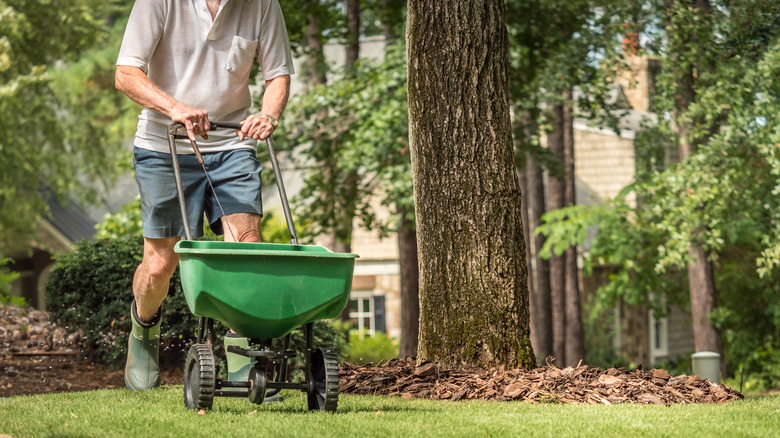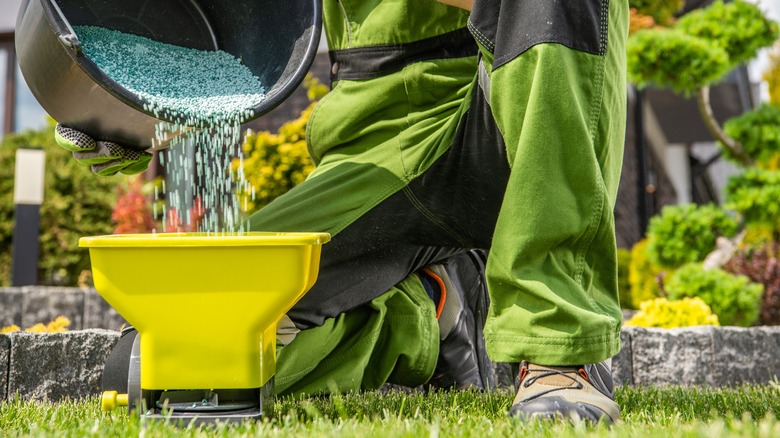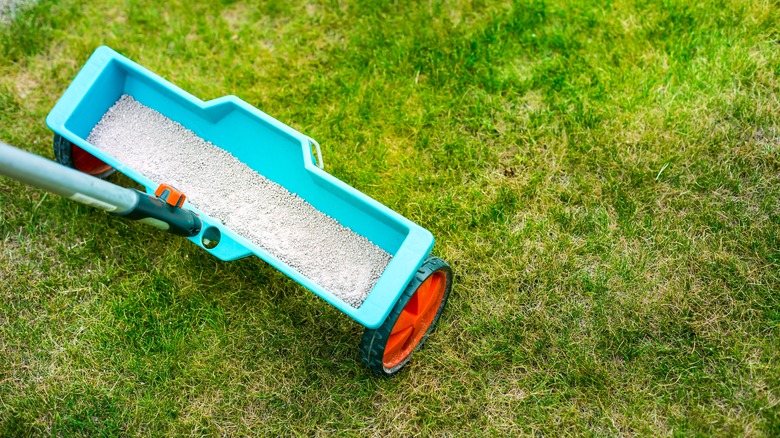Don't Make This Big Mistake When Using A Lawn Spreader In Your Yard
If your property has a sprawling lawn, you're probably familiar with the maintenance requirements for keeping its verdant beauty. Using a lawn spreader is common for lawn maintenance, whether you're spreading seed, fertilizer, or soil amendments. One important step for operating one of these tools is its calibration. Calibrating a lawn spreader is essential for achieving accurate and uniform application of fertilizers, pesticides, or seeds across the lawn. Proper calibration ensures that the spreader distributes the desired amount of material evenly, preventing over or under-application. Calibration is essential for promoting healthy grass growth, controlling weeds, and avoiding environmental damage.
One benefit of calibrating your lawn spreader is improved efficiency. By knowing the exact output of the spreader, you can calculate the appropriate amount of material needed for their lawn size, minimizing waste and saving both time and money. Additionally, calibrated spreaders help maintain consistency in application, resulting in a more uniform appearance and distribution of nutrients or seedlings. Another advantage is environmental protection. Over-application of fertilizers or pesticides can lead to runoff, contaminating waterways and harming aquatic ecosystems. Calibrating the spreader ensures that only the necessary amount of material is applied to your lawn, reducing the risk of pollution.
Using a lawn spreader without proper calibration is a mistake that poses several risks. Over-application can lead to nutrient imbalances in the soil, causing excessive growth, increased susceptibility to diseases, and environmental harm. Conversely, under-application may result in inadequate weed control or nutrient deficiency, compromising the health and appearance of your lawn.
How to calibrate your lawn spreader
Calibrating your lawn spreader is a straightforward process that involves a few key steps. First, choose the material you'll be spreading. Next, determine the appropriate application rate based on the product label or recommended guidelines for your specific lawn needs. This information will help you calculate the spreader's output and ensure accurate distribution. Then prepare a known quantity of the material to use for calibration. This could be as simple as measuring a certain weight or volume of the material. For example, you might measure 1 pound of fertilizer or 1 cup of seed.
After preparing the calibration material, fill the spreader hopper with the measured quantity. Then, adjust the spreader settings according to the manufacturer's recommendations or your calculations based on the desired application rate. With the spreader loaded and settings adjusted, walk at a consistent pace over a predefined area of your lawn, spreading the calibration material as you go. Take note of any adjustments you need to make to ensure even distribution and coverage. Once you've finished spreading the calibration material, measure the area covered and compare it to the known quantity you applied. This will allow you to calculate the actual application rate of your spreader.
Additionally, it's best to calibrate your lawn spreader before each new season or whenever you switch to a different type of material. If you notice inconsistent application during lawn maintenance, it's a good idea to recalibrate the spreader to ensure optimal performance.
Precautions for using a lawn spreader
Calibrating a lawn spreader involves handling potentially hazardous materials and operating machinery, so it's essential to take necessary precautions to ensure safety. Always wear appropriate personal protective equipment such as gloves, safety goggles, and a mask to protect against contact with the calibration material and any potential dust or fumes. Before starting the calibration process, ensure that the area is clear of obstacles and bystanders to prevent accidents while walking with the spreader. If the calibration material is a chemical substance, be aware of any specific safety precautions outlined on the product label, such as avoiding skin contact or inhalation of fumes.
While adjusting the settings on the spreader, follow the manufacturer's instructions carefully to prevent damage to the equipment and ensure accurate calibration. Be cautious when handling any moving parts or making adjustments to avoid pinching or trapping fingers. When walking with the spreader to distribute the calibration material, maintain a steady pace and be mindful of your surroundings to avoid tripping or stumbling. If the ground is uneven or slippery, use caution to prevent slips and falls.
After completing the calibration process, clean the spreader thoroughly to remove any remaining calibration material and prevent contamination or cross-contamination with other substances during future use. Taking appropriate safety precautions and following proper procedures when calibrating a lawn spreader can help minimize risks and ensure a safe and effective calibration process, helping to keep your lawn green and beautiful all season long.


